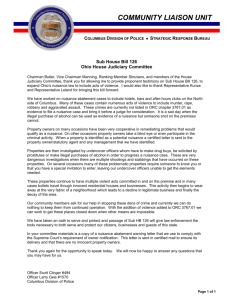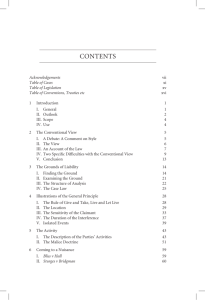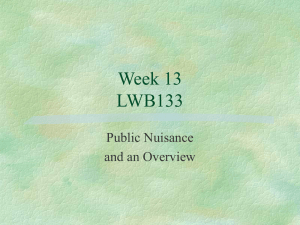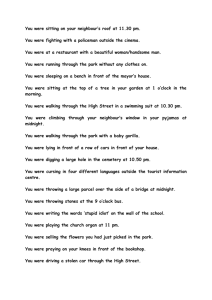ownership - Africonsultgroup
advertisement
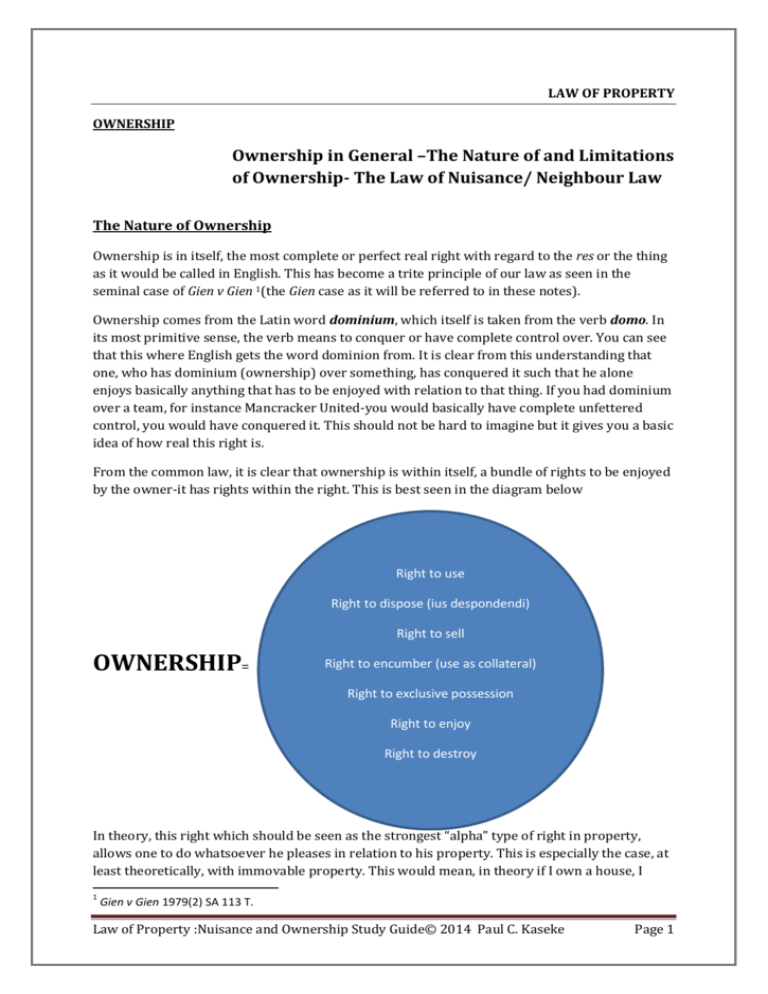
LAW OF PROPERTY OWNERSHIP Ownership in General –The Nature of and Limitations of Ownership- The Law of Nuisance/ Neighbour Law The Nature of Ownership Ownership is in itself, the most complete or perfect real right with regard to the res or the thing as it would be called in English. This has become a trite principle of our law as seen in the seminal case of Gien v Gien 1(the Gien case as it will be referred to in these notes). Ownership comes from the Latin word dominium, which itself is taken from the verb domo. In its most primitive sense, the verb means to conquer or have complete control over. You can see that this where English gets the word dominion from. It is clear from this understanding that one, who has dominium (ownership) over something, has conquered it such that he alone enjoys basically anything that has to be enjoyed with relation to that thing. If you had dominium over a team, for instance Mancracker United-you would basically have complete unfettered control, you would have conquered it. This should not be hard to imagine but it gives you a basic idea of how real this right is. From the common law, it is clear that ownership is within itself, a bundle of rights to be enjoyed by the owner-it has rights within the right. This is best seen in the diagram below Right to use Right to dispose (ius despondendi) Right to sell OWNERSHIP= Right to encumber (use as collateral) Right to exclusive possession Right to enjoy Right to destroy In theory, this right which should be seen as the strongest “alpha” type of right in property, allows one to do whatsoever he pleases in relation to his property. This is especially the case, at least theoretically, with immovable property. This would mean, in theory if I own a house, I 1 Gien v Gien 1979(2) SA 113 T. Law of Property :Nuisance and Ownership Study Guide© 2014 Paul C. Kaseke Page 1 should be entitled to do what I want with it because I have the strongest right in relation to it – the right of ownership. Of course this view of the right cannot remain true when tested against a society with human beings in it-that right has to somewhat be limited because it is too unfettered, too uncontrolled and has the potential to do more harm than good if every owner does what they please with their ‘thing’ even when it infringes on other owners’ rights. This was the reasoning of Spoelstra AJ for the court in Gien, who held that the seemingly unlimited freedom of ownership is partially true because it has to be exercised within the boundaries of the law. In essence what the court was saying here is that yes one has the right to do whatsoever he pleases with respect to his ‘res’ BUT it has to be within the boundaries of the law. Spoelstra AJ goes on to define this idea of the boundaries of the law. There are two such boundaries to an owner’s seemingly unfettered power- the objective law and the restrictions from the rights of others. The Objective Law This concept relates to any legal rule or principle from recognised sources of law which places limitations on the use of property. In other words, the State can for instance, determine how an owner ought to use his property even though the owner has unfettered and unlimited control. Let me show you how. Let’s assume for illustrative purposes you are Mr Jupiter and you are a billionaire who happens to own a private jet. Owning the jet does not mean you can land when and where you please –regardless of who you know or how much you have. The State through various statutes, can prescribe for instance that you need to be cleared to land at any landing strip in the country 24 hours in advance and that you cannot fly your jet to Air Force bases for obvious security reasons. The State does not own your jet but can through the objective law (statutes in this instance) limit how you enjoy your right as owner. This then is an obvious limitation to the theoretic unfettered ownership rights. The Rights of Others This is a relatively broad concept that basically boils down to the fact that the exercise of the rights associated with ownership can clash with the rights of other people’s rights. It could even be that one’s rights of ownership actually stop someone from enjoying their own property fully. Let’s use the following illustration: Mr Potato Head has a large African Potato Tree that shoots up 45 metres from the ground but in so doing fully covers Mr Rasta Mouse’s town house such that he enjoys no sunlight and all his vegetables die due to a lack of the sun. If we go by the initial understanding we had of ownership being unfettered and unlimited then this right would go against Mr Rasta Mouse’s own right to enjoy his property(in particular, his vegetable garden , patio etc.). If we only used the objective law to limit ownership enjoyments and there was no law prohibiting Mr Potato Head’s activities, poor Mr Rasta Mouse would have nothing to enjoy from his garden. Oh no! Poor Mr Rasta Mouse! Thankfully, this is why the court in Gien rightly stated the second boundary is that of the rights of others. In such a conflict, the courts will weigh the competing interests of the two neighbours to settle the two amicably. This brings us to the area of Nuisance Law, more loosely referred to as Neighbour Law. Law of Property :Nuisance and Ownership Study Guide© 2014 Paul C. Kaseke Page 2 THE LAW OF NUISANCE /NEIGHBOUR LAW WHAT IS IT ? It is the law applicable to people who own adjacent or proximate immovable property. What do you think about it applying to movable property? It is a limitation on the ownership of one party “for the peaceful co-existence of neighbours”. It is the hallmark of a peaceful neighbourhood-why? PURPOSE: This area of law exists to balance the competing interests of the ‘bad’ neighbour (Mr Potato Head for instance) to exercise his rights of enjoyment as owner and the ‘good’ neighbour to enjoy his own space. Of course, the use of the terms good and bad is in layman terms and not an accurate description of the relationships. As you work through the cases , you will see that the ‘bad ‘ neighbour may not even have any bad intentions but is using his property in the best way he thinks he can or should. It may even be that the ‘good’ neighbour is petty and likes to raise complaints about minor things so these terms must not stick to your mind but should serve only as illustrative aids. They should never ever find their way on your exam script! BASIC PRINCIPLES IN NEIGHBOUR LAW In our law, these are largely set out in the case of Gien v Gien Gien v Gien (1979) Facts Respondent created a device to scare away baboons from his garden and store but the device was so loud that it affected the Respondent’s neighbours on the adjacent farm. It was also set in such a way as to keep it running all day despite the fact that it could be used during the day and still be as effective while switched off at night. The Applicant brought this to the attention of the Respondent who rejected this notion because he felt that it was not his neighbour’s place to tell him what to do with his property. This led to the Applicant applying for an interdict Spoelstra AJ for the court, held that:1. Where neighbours’ rights conflict , courts must determine and resolve the conflict on the facts of each case .In other words , this area of law is not made of rigid rules but is extremely case specific and flexible in application. No two neighbours are the same and as such you must always remember each case presents a new twist to the application of the Law of Nuisance. 2. The cardinal rule in Nuisance Law is that each neighbour is obliged to tolerate the normal use of an adjacent property much in the same way he would also want his neighbours to tolerate his normal use of his property. 3. The cardinal rule in 2 above is limited when the normal use evolves and transforms into abnormal use. The use in other words, is no longer what the neighbour is obliged to tolerate as it is asking too much of an ordinary man to bear an extraordinary burden. Law of Property :Nuisance and Ownership Study Guide© 2014 Paul C. Kaseke Page 3 4. The court should in each case, ask itself four core questions. We can, for our ease, refer to these as the ‘core formula’ of nuisance law. These are: a. Is the infringing conduct of the offending neighbour reasonable and /or fair? b. Is the infringing conduct in bad faith or with malice (intention to offend /harm)? c. Is the use abnormal or normal? d. Is the Applicant an abnormally sensitive person or are we dealing with the reasonable man? 5. There are also some case specific questions to be dealt with in each case. In this case the court considered the following questions in relation to the ‘baboon device’: a. The locality of the noise b. The level of the noise c. The frequency of the noise d. The time of the noise e. The type of noise f. The intensity and degree of persistence 6. The test is an objective test 7. The Applicant (‘good’ neighbour) must show that some prejudice has been suffered. What about potential prejudice? Will it suffice for a prohibitory interdict? 8. The underlying test really is that of reasonableness and fairness. 9. The two remedies are 1) Prohibitory interdicts which do not require fault and 2) the Aquilian action that requires fault. Using the reasoning of the court in Gien, how would you resolve the following situation: Handsome Me and Beautiful You are neighbours in a stunning student complex, North Point where they have both bought rooms because they were born in so much money they don’t know what to do with it. Handsome Me loves to play Gospel music all night long at maximum volume because it brings him closer to his creator. Beautiful You is a very relaxed and conservative lady , she rarely goes out and sleeps in. Though she is a deep sleeper , she finds that she cannot sleep at night due to Handsome Me’s Gospel music. She speaks to him the next day with the intention of asking him to tone things down but Handsome Me will have none of it. He calls her a heathen who cannot stand the music because she is burning inside due to her ‘evil sins’ consuming her. Beautiful You is offended and approaches you for advice. Regal v African Superslate Added to the principles laid out above , we now turn to the case of Regal which in fact is older than the Gien case . It gives more insight into the principles of reasonableness and fairness. So far, we have understood the law to be telling us that one cannot place an undue burden on his neighbours beyond what is normal. Regal’s facts are fairly simple: two properties were located adjacent to each other over a river. The ‘offending’ property 2 had a quarry next to it where slate deposits were kept. The currants from the river washed these deposits from that land to the neighbour’s land. The neighbour logically complained of this and further lodged an application for an interdict to stop the neighbour’s slate from being washed onto his land. 2 The word ‘offending’ here is used in its civil law context and not in its criminal context. Law of Property :Nuisance and Ownership Study Guide© 2014 Paul C. Kaseke Page 4 Steyn CJ held for the court that: 1. There was sufficient evidence that the slate which ended up on Regal’s land was marginal and not as excessive as one would imagine; 2. The nature of the quarry site itself would mean that this would be termed as normal use of a quarry i.e. slate will occasionally find its way onto people’s property. The question accordingly was , if in this situation , the slate wash-up was excessively beyond the normal use of a property in its context; 3. Generally , ownership is unfettered except to the extent that it unreasonably or unfairly prejudices the rights of neighbours; 4. Liability for damages can only arise where it is fair to expect the owner to avert the damages. Conversely, if it is unfair to expect the owner to avert harm for whatever reason (expense, minor nature of nuisance, impossibility) then liability for damages under nuisance law will fail-the application for an interdict will not succeed. 5. For interdicts against future harm, it must still be reasonably fair to expect the Respondent to take measures to avert harm. 6. Emphatically stresses the importance of the underlying principles of reasonableness and fairness. Whatever outcome is reached by a court in resolving a nuisance, it must always be reasonable and fair. That is the bottom line test-REASONABLENESS, FAIRNESS. On the facts, the court held that it would be unfair to erect an expensive wall (since this was the Applicant’s prayer) for a minor nuisance which was part of the normal use of that property. Do you agree with the judgment of the court? REASONABLENESS + FAIRNESS Allaclas Investments v Milnerton Golf Club Our survey of the law has shown us thus far, that as long as the nuisance complained of falls under normal use, then there will be no actionable nuisance but also that if one wants to apply the law of nuisance, it has to be abnormal use . The Allaclas case slightly changes our understanding in that regard as we will find that even what is normal use can result in an interdict-subject to a particular threshold test. Law of Property :Nuisance and Ownership Study Guide© 2014 Paul C. Kaseke Page 5 Allaclas Investments v Milnerton Golf Club (2008) Facts A family bought a house on a golf estate (the Milnerton Golf Estate) adjacent to the 6th hole fairway where in a space of over 28 months , roughly 875 balls landed onto the property. It later became apparent that the 6th hole was in fact badly constructed and that even the average golfer would end up hitting directly at the applicant’s house. The Applicant sought an order prohibiting the use of the 6th hole until such measures had been taken to reduce the number of balls into their property. Interesting to note the First Appellant is in actual fact the Owner of the house as a corporate entity and the Second Appellant is the Director of the first Appellant. The company was more concerned than the actual family staying there. Can you think of any reasons why? What does it mean for purposes of locus standi in such cases ? The case was first heard in the cape High Court where Traverso DJP held that: The Applicant had knowledge of the fact that the property was located in a golf estate and as such should have known that this would mean there would be a high incidence of stray balls; In moving to such a place the High Court suggested that in a way this seemed like a tacit acceptance of the normal use of the golf course which included the high incidence of balls; The stray balls were classified as being the normal use of the property and the Applicant was expected to bear and tolerate such use; The Applicant had the onus to produce evidence that the balls were an undue burden and unreasonable beyond the normal use. This was a higher onus than previous cases on nuisance law especially because the Applicant had already produced such evidence. On appeal in the SCA , Farlam JA for the court , held that: 1. Indeed the incidence of stray balls would constitute the normal use for that property; 2. However , the normal use threshold of what is reasonable for any neighbour to endure in the circumstances was exceeded because the 875 was a high number even by comparative statistics. He also added that this threshold had been exceeded by virtue of evidence that attested to the poor design of the 6th hole which increased chances of stray balls; 3. Though this was indeed normal use (the incidence of balls) , it had been exceeded and became abnormal use due to the threshold of tolerance being exceeded. Parties may Law of Property :Nuisance and Ownership Study Guide© 2014 Paul C. Kaseke Page 6 well be within their normal use of property but this may be exceeded and once there is evidence to suggest that it would be unfair and unreasonable to expect the reasonable neighbour to tolerate such use , the nuisance is actionable at law and 4. As a remedy , the court ordered the erection of a safety net that would be able to minimize the number of balls that went astray. This is a novel remedy to the law of nuisance as so far , we have only come across the prohibitory interdict and the Aquilian action for damages. Here the court used in effect , a mandatory interdict. SUGGESTED READINGS 1. A J Van Der Walt and GJ Pienaar Introduction to the Law of Property (6ed) (Juta) 2009, Chapters 4 and 7. 2. Allaclas Investments v Milnerton Golf Club 2008 (3) SA 134 (SCA). 3. Assagay Quarries (Pty) Ltd v Hobbs 1960(4) SA 237 (N). 4. Campbelltown Golf Club Ltd v Winton [1998] NSWSC 257(unreported judgment). 5. Cosmos (Pty) Ltd v Phillipson 1968 (3) SA 121 (R). 6. De Charmoy v Day Star Hatchery (Pty) Ltd 1967 (4) SA 188 (D). 7. Gien v Gien 1979(2) SA 1113(T). 8. LAWSA Vol. 27 paras 294 to 321. 9. Malherbe v Ceres Municipality 1951(4) SA 500 (AD) especially at 511-520. 10. PGB Boerdery Belggings Edms Bpk v Somerville 62 (Edms) Bpk [2007] SCA 145 (RSA). 11. Regal v African Superslate(Pty)Ltd 1963 (1) SA 102 (A). 12. The Digesta at 8.5.8.5. Law of Property :Nuisance and Ownership Study Guide© 2014 Paul C. Kaseke Page 7

